Tall drought-resistant hedges offer significant advantages over traditional fences. You’ll enjoy their natural beauty while benefiting from superior wind resistance, as flexible branches bend rather than break during storms. These living barriers provide enhanced security through thorny vegetation, purify surrounding air, and create natural temperature regulation around your property. Once established, they require minimal water while adapting to challenging terrain. Discover how these sustainable alternatives can transform your landscape while supporting local wildlife.
The Natural Beauty Advantage of Living Barriers
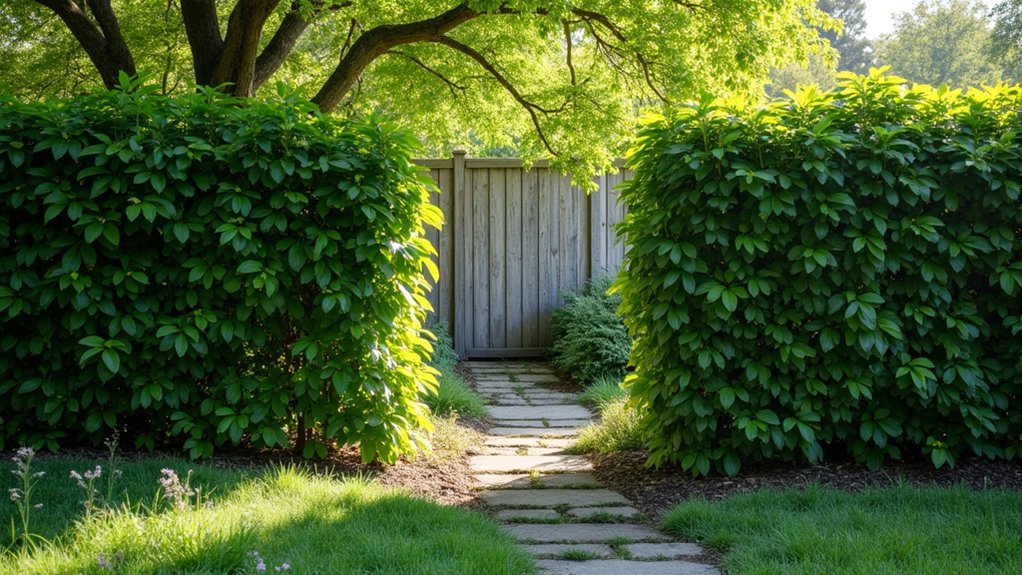
While solid fences create stark, artificial boundaries, tall drought-resistant hedges transform your property into a living canvas of natural beauty.
Species like Texas Sage and Manzanita offer a seamless integration with your landscape, providing a low maintenance solution that blends with the natural environment.
You’ll enjoy seasonal changes as these Drought-Tolerant Privacy Hedges cycle through different blooms and foliage, creating dynamic visual interest year-round.
Unlike static fences, hedges add texture and depth, softening your yard’s appearance with layers of verdant character.
They’re a great option for enhancing biodiversity too—flowering varieties such as Oleander and California Lilac attract pollinators while absorbing ambient noise.
This creates a more serene outdoor space where natural beauty and functionality merge perfectly.
Superior Wind Resistance and Storm Durability
Unlike rigid fences that catch wind like sails, tall drought-resistant hedges offer remarkable resilience during stormy weather.
You’ll find these living barriers allow wind to pass through their semi-porous structure, dramatically reducing force impact during severe weather events.
Fast growing hedge varieties develop flexible branches that bend rather than break when confronted with powerful gusts.
Resilient hedge branches dance with the wind’s force, yielding without surrendering their protective stance.
Their extensive root systems anchor them firmly in place, preventing the uprooting that commonly affects solid barriers during extreme conditions.
Research consistently shows that extremely drought tolerant hedges withstand storms better than conventional fencing.
Their natural design creates an effective windbreak that protects your property while maintaining structural integrity.
When you choose hedges with superior wind resistance, you’re investing in a long-term solution that stands strong when weather conditions become challenging.
Enhanced Security Through Thorny Vegetation

Beyond their storm resilience, drought-resistant hedges can form a robust security system for your property.
When you choose thorny species like blackthorn or hawthorn, you’re creating a natural barrier that outperforms typical fences. Intruders find these living walls nearly impossible to breach, as the thorns provide a formidable defense that solid barriers simply can’t match.
- Natural deterrent – The dense, thorny structure requires more time and effort to overcome, discouraging potential intruders before they even attempt entry.
- Tamper-resistant protection – Unlike fences that can be cut or dismantled, thorny hedges resist damage and provide long-lasting security.
- Strategic concealment – The irregular growth patterns obscure visibility, making it difficult for outsiders to assess your property and plan an approach.
Air Purification Benefits of Tall Privacy Hedges
As urban pollution continues to threaten public health, drought-resistant hedges offer remarkable air purification capabilities that transform your property into a clean-air sanctuary. Your tall privacy hedge serves as a powerful natural filter, reducing black carbon by up to 63% and trapping harmful ultrafine particles before they reach your lungs.
| Benefit | Function | Impact |
|---|---|---|
| Air purification | Absorbs pollutants | 63% reduction in black carbon |
| Carbon sequestration | New growth captures CO₂ | Combats climate change |
| Noise reduction | Dense foliage blocks sound | Creates quieter outdoor spaces |
Even in hot and dry conditions, drought-resistant varieties continue their air-cleaning work while supporting local wildlife. You’ll enjoy cleaner air and contribute to biodiversity—advantages no fence can provide, regardless of how sturdy or attractive it might be.
Noise Reduction Properties of Dense Foliage
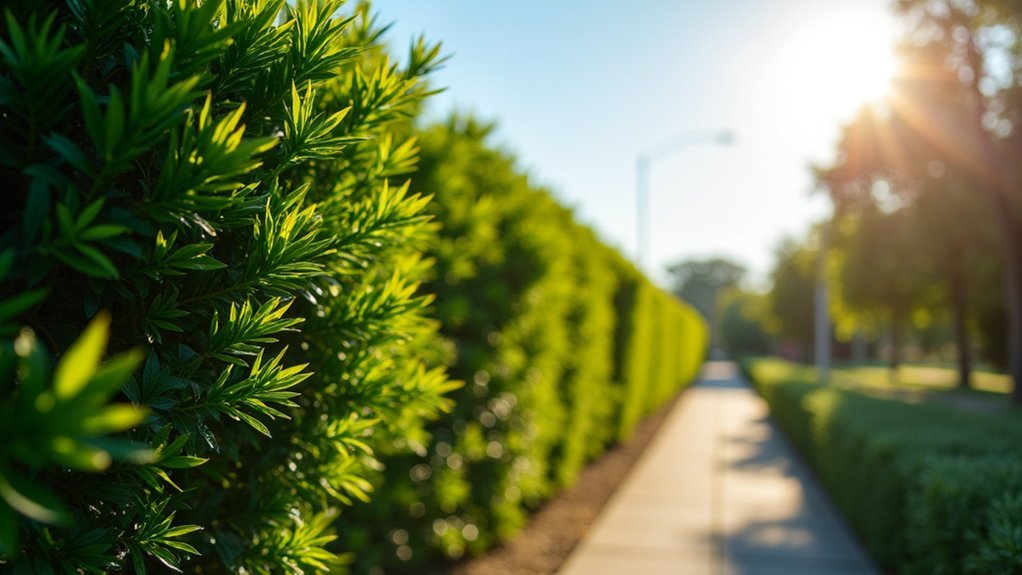
You’ll find that tall, drought-resistant hedges act as natural sound absorbers, capturing up to 10 decibels of noise through their irregular, dense foliage structure.
Unlike solid fences that merely reflect sound waves, these living barriers actually absorb and diffuse noise from roads and high-traffic areas.
The taller your hedge grows, the more effective it becomes at creating an acoustic shield while simultaneously supporting biodiversity that enhances your property’s natural soundscape.
Sound Wave Absorption
The peaceful sanctuary of a backyard can be shattered by persistent traffic noise or noisy neighbors.
When comparing the pro vs con of fences versus hedges, tall drought-resistant hedges clearly take the lead in sound absorption capabilities from spring to keep year-round.
Unlike solid fences that merely reflect sound waves, hedges actually absorb and diffuse them through their complex structure:
- Their multi-dimensional foliage disrupts sound propagation, reducing noise by up to 50% more effectively than flat fence surfaces.
- The varying heights and densities within hedges create natural sound diffraction zones.
- The porous nature of leaf arrangements allows sound waves to be captured rather than bounced back.
You’ll experience a noticeably quieter outdoor environment with hedges as your natural sound barrier.
Natural Acoustic Barriers
Beyond basic sound wave absorption, dense hedge foliage creates extensive natural acoustic barriers that transform your outdoor living space. Your tall hedge can reduce noise levels by up to 10 decibels—comparable to solid fences but with superior acoustic properties.
Unlike hard surfaces that reflect sound waves, the flexible nature of living plants dissipates noise more effectively.
You’ll notice how thick hedge structures muffle exterior disturbances by absorbing harmful ultrafine particles that contribute to noise pollution. This natural sound barrier works continuously to create a quieter environment without the harsh boundaries of traditional fencing.
As an added benefit, the biodiversity supported by your hedge further enhances the serene atmosphere by minimizing disruptive sounds, making your outdoor space not just visually appealing but acoustically pleasant as well.
Creating Wildlife Habitats While Maintaining Privacy
While seeking privacy in your outdoor space, establishing tall drought-resistant hedges can simultaneously create thriving sanctuaries for local wildlife. Unlike rigid fences, these living barriers offer food sources and shelter that foster biodiversity right in your backyard.
Transform your boundaries into biodiversity hotspots by planting living privacy screens that nurture wildlife while sheltering your sanctuary.
You’ll enjoy multiple benefits when you plant native species like Coyote Brush or Manzanita:
- The dense foliage muffles noise from roads or schools while providing nesting sites for birds.
- Your hedge acts as a natural air filter, reducing pollution exposure for both your family and garden visitors.
- By attracting beneficial insects and birds, you’ll enhance the ecological balance of your garden while maintaining complete privacy from neighbors.
These multifunctional hedges create the perfect balance between personal seclusion and supporting local wildlife ecosystems.
Long-Term Cost Efficiency of Drought-Resistant Species
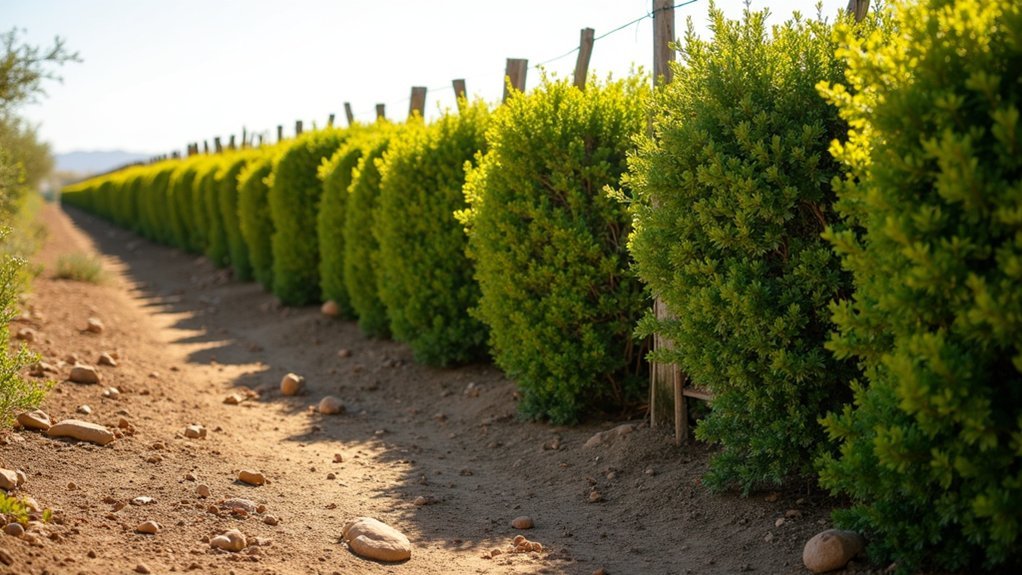
When considering the financial aspects of landscaping, drought-resistant hedges offer remarkable long-term savings compared to traditional fencing options.
You’ll find the initial investment considerably lower, especially when starting with smaller plants or cuttings of varieties like Texas Sage and Manzanita.
Once established, these resilient hedges require minimal watering and maintenance, dramatically reducing your ongoing costs.
Unlike fences that need periodic repairs or complete replacement after weather damage, drought-resistant hedges flex during storms and recover naturally thanks to their robust root systems.
You’ll also benefit from unexpected savings as these living barriers improve your property’s air quality and reduce noise pollution, potentially increasing your home’s value while lowering energy costs.
They thrive even in poor soil conditions, requiring far less attention than conventional landscape options.
Top Drought-Tolerant Varieties for Maximum Height
You’ll find remarkable height potential in drought-hardy champions like California Lilac, which can soar to 20 feet while offering stunning flowers and pollinator benefits.
Nature’s resilient barriers, such as Manzanita and Texas Privet, provide impressive vertical screening while withstanding the harshest dry conditions.
For maximum privacy with minimal water, consider these low-water height heroes alongside Coyote Brush and Texas Ranger, which reach nine and eight feet respectively, creating effective living walls in challenging climates.
Towering Drought-Hardy Champions
For those seeking both privacy and sustainability, drought-resistant hedges that reach impressive heights offer the perfect solution.
California Lilac stands out as a champion, soaring up to 20 feet while attracting beneficial pollinators with its vibrant blooms.
Texas Sage creates an effective 8-foot barrier that thrives in hot, arid conditions without demanding constant watering.
Manzanita species deserve special attention as they:
- Establish deep root systems that require minimal irrigation once mature
- Provide year-round visual interest with distinctive reddish bark
- Adapt to challenging western landscapes where traditional hedges struggle
Heavenly Bamboo and California Buckthorn round out your options, reaching 6+ feet while offering additional benefits—the former providing multi-season interest, the latter producing edible berries alongside its privacy-ensuring height.
Nature’s Resilient Barriers
Creating impenetrable natural screens that withstand harsh conditions requires selecting the right drought-resistant varieties that achieve impressive heights.
Texas Sage and Manzanita stand out as exceptional choices, reaching 8 to 20 feet while demanding minimal watering.
California Lilac offers dual benefits—growing up to 20 feet tall while attracting beneficial pollinators that enhance your garden’s biodiversity.
Unlike rigid fences that can collapse in storms, these flexible hedge options bend rather than break during high winds.
What makes these varieties truly superior is their deep root systems, which provide remarkable stability and resilience in challenging environments.
You’ll find these drought-tolerant champions thrive in full sun and hot climates, maintaining their dense foliage and impressive height even when water is scarce.
Low-Water Height Heroes
While many gardeners struggle to find plants that provide both height and drought resistance, several exceptional varieties stand out for achieving impressive vertical growth with minimal water requirements.
California Lilac towers above most options, reaching an astonishing 20 feet while attracting essential pollinators to your garden ecosystem.
You’ll find Coyote Brush equally impressive, growing up to nine feet tall while requiring almost no irrigation once established.
- Manzanita varieties offer exceptional drought tolerance native to California’s challenging climate.
- Texas Ranger delivers vibrant purple blooms while growing to eight feet with only occasional deep watering.
- Heavenly Bamboo exceeds six feet in height, combining privacy screening with aesthetic appeal despite slower growth.
These height heroes prove you don’t need to sacrifice privacy for water conservation.
Seasonal Considerations for Year-Round Screening
When planning your privacy hedge, seasonal changes deserve careful thought to guarantee your outdoor space remains sheltered throughout the year. Deciduous varieties will shed leaves in winter, exposing your yard, while evergreen options maintain consistent coverage regardless of season.
During spring and summer, dense foliage from tall hedges not only screens you from passersby but also attracts beneficial wildlife, enriching your garden’s ecosystem.
Tall, leafy hedges create natural sanctuaries that shelter both you and garden wildlife during warmer months.
Opt for drought-resistant varieties like Texas Sage and Manzanita that thrive in hot, dry conditions with minimal watering.
Taller hedges adapt better to varying weather conditions, creating a flexible barrier that withstands wind while maintaining privacy.
Minimal Water Requirements After Establishment
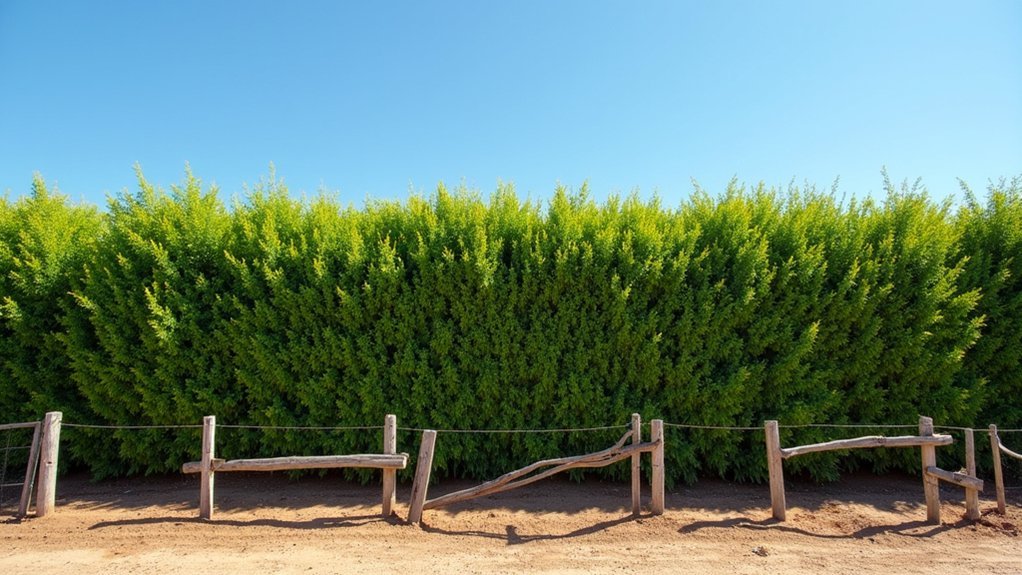
Once established, your tall drought-resistant hedge will thrive with minimal or no supplemental watering, often surviving on natural rainfall alone.
You’ll notice these resilient plants developing deep root systems that access underground moisture sources, enabling them to withstand extended dry periods without stress.
This water independence makes drought-resistant hedges particularly valuable in arid climates where conservation matters and in challenging locations where regular irrigation isn’t practical.
Survival Without Irrigation
After investing time in proper establishment, you’ll find that tall drought-resistant hedges become remarkably self-sufficient.
Species like Texas Sage and Manzanita thrive on natural rainfall alone, making them perfect for water-scarce areas. Their deep root systems access moisture from lower soil layers, ensuring survival during extended dry periods without supplemental watering.
Unlike traditional fences that offer zero ecological benefits, these living barriers contribute to your landscape’s sustainability while providing privacy:
- California Lilac and Texas Ranger varieties create effective privacy screens while requiring minimal maintenance.
- Golden Privet and Forsythia hedges reduce water runoff and improve soil health naturally.
- Most drought-tolerant hedges can survive indefinitely on rainfall once established, eliminating irrigation costs.
You’ll enjoy both environmental benefits and reduced maintenance compared to conventional fencing options.
Long-Term Water Independence
The long-term water independence of these hedges represents their most valuable asset for water-conscious homeowners. You’ll find that after the initial establishment period, species like Lavender and Texas Ranger require virtually no supplemental watering, unlike fences that offer no water benefits whatsoever.
| Hedge Type | Water Needs | Benefits |
|---|---|---|
| Texas Sage | Minimal | Thrives in hot conditions |
| Manzanita | Very low | Adapted to arid climates |
| Lavender | Self-sustaining | Attracts beneficial insects |
Adapting to Challenging Terrain and Soil Conditions
Steep hillsides and poor soil conditions that would typically frustrate gardeners present ideal opportunities for tall drought-resistant hedges to showcase their remarkable adaptability.
Unlike rigid fences that fight against the natural landscape, species like Texas Sage and Manzanita work with your terrain’s unique features.
- Their extensive root systems stabilize soil on slopes, preventing erosion while creating a living barrier that enhances your property’s integrity.
- You’ll find these hedges thrive in full sun with minimal watering once established, making them perfect for hard-to-reach areas where regular maintenance isn’t practical.
- When planted in staggered rows, they create a more natural aesthetic that follows your land’s contours while managing water runoff far better than traditional fencing.
Natural Temperature Regulation Around Your Property
While many homeowners invest thousands in artificial climate control solutions, tall drought-resistant hedges silently create their own microclimate around your property, naturally moderating temperature extremes year-round. Their dense foliage blocks direct sunlight, reducing ground temperatures and your reliance on air conditioning.
| Benefit | Summer Effect | Winter Effect |
|---|---|---|
| Insulation | Reduces heat absorption | Maintains warmth |
| Wind Control | Creates cool air corridors | Blocks cold drafts |
| Humidity Regulation | Releases moisture through transpiration | Stabilizes moisture levels |
You’ll notice these living barriers act as both shield and regulator—blocking harsh sun while releasing cooling moisture through transpiration. By supporting local biodiversity, they create a complete ecosystem that further enhances temperature regulation and improves air quality around your home.
Environmental Impact: Carbon Capture and Sustainability
Beyond their aesthetic appeal, tall drought-resistant hedges serve as powerful environmental allies in your landscape strategy. These living installations work tirelessly to combat climate change through consistent carbon dioxide absorption and oxygen production—something no manufactured fence can offer.
- Carbon Capture Champions – Your hedge actively removes carbon dioxide from the atmosphere through photosynthesis, directly contributing to climate change mitigation while wooden fences actually release carbon as they decompose.
- Pollution Filters – Research shows hedges can reduce black carbon exposure by up to 63%, creating a healthier microclimate around your property.
- Water Conservation – Unlike traditional lawns that demand frequent watering, drought-resistant hedges require minimal irrigation once established, conserving precious water resources while simultaneously supporting local biodiversity.
Frequently Asked Questions
Why Are Hedges Better Than Fences?
Hedges are better than fences because they’re more wind-resistant, provide better security, improve the environment, cost less to maintain, and offer natural privacy while looking beautiful. You’ll benefit from their ecological advantages too.
What Is the Best Hedge to Block Neighbors?
For blocking neighbors’ view, you’ll find Golden Privet and Forsythia excellent choices. They grow 10-20 feet tall, create dense privacy screens, and are more effective barriers than fences. Texas Privet works well in dry areas.
What Is the Most Drought-Resistant Hedge?
For extreme drought resistance, you’ll find Texas Sage, Manzanita, and Coyote Brush exceptional. They’ll thrive with minimal water once established, offering beautiful foliage while requiring almost no maintenance in arid conditions.
Which Is Cheaper, a Hedge or a Fence?
Hedges are often cheaper than fences. You’ll save money initially by starting with small plants or cuttings, and you’ll enjoy lower long-term maintenance costs while gaining environmental benefits that offset your investment.
In Summary
You’ve seen how drought-resistant hedges offer undeniable advantages over traditional fencing. They’re not just beautiful—they’re functional powerhouses that clean your air, reduce noise, and enhance security while requiring minimal water. As you plan your property boundaries, remember that these living barriers adapt to challenging conditions while capturing carbon. It’s a smart investment that’ll benefit your property and the planet for decades to come.
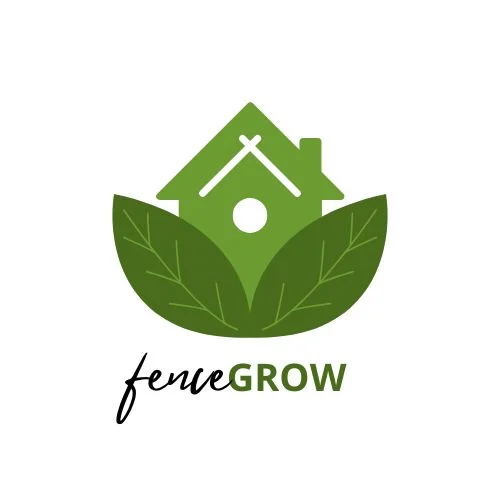
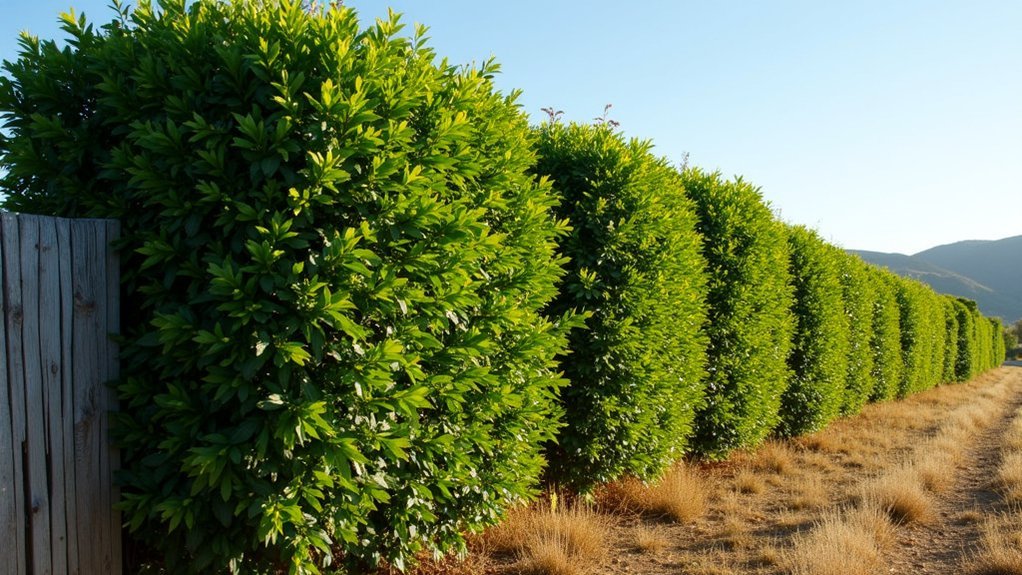

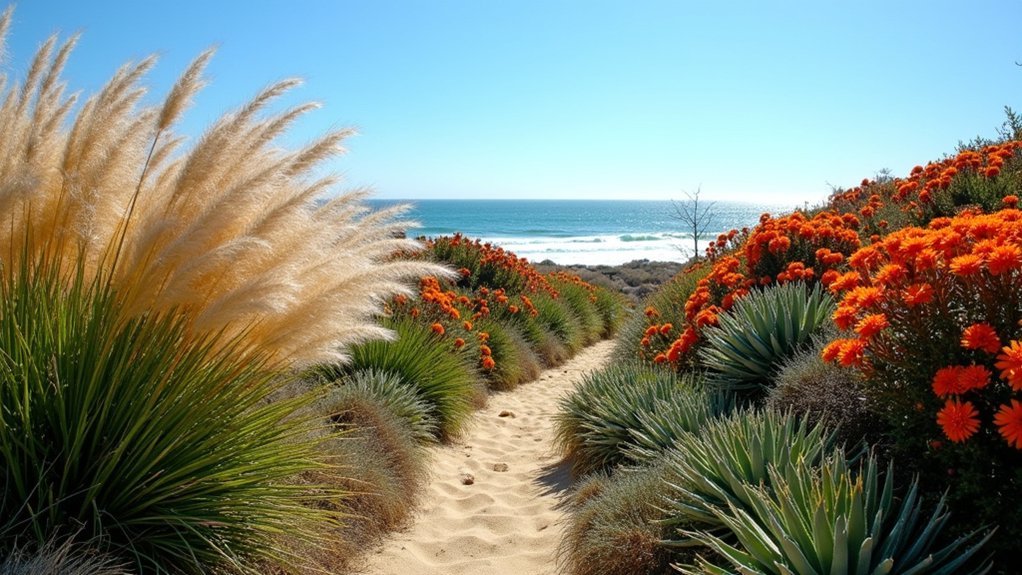
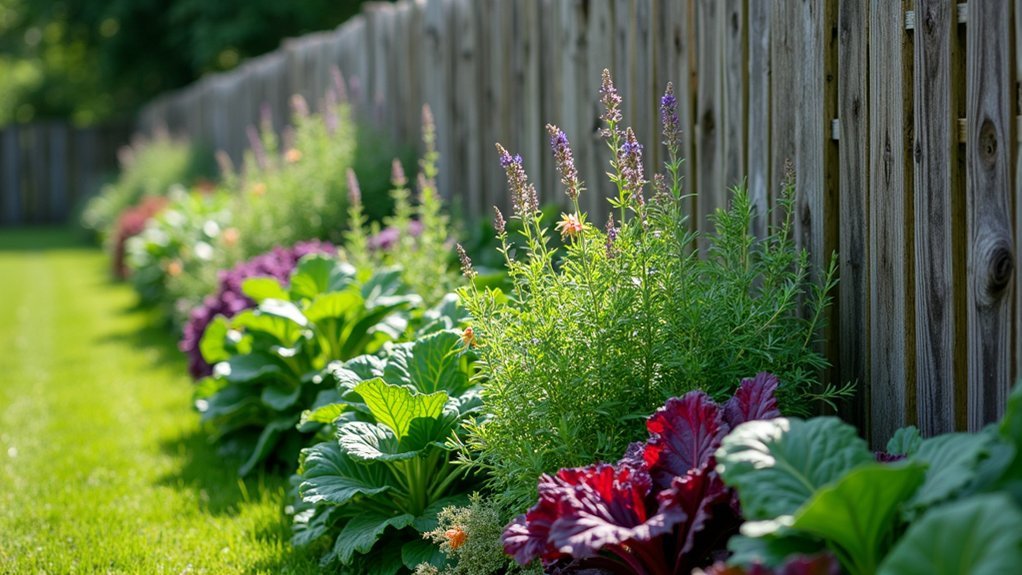
Leave a Reply